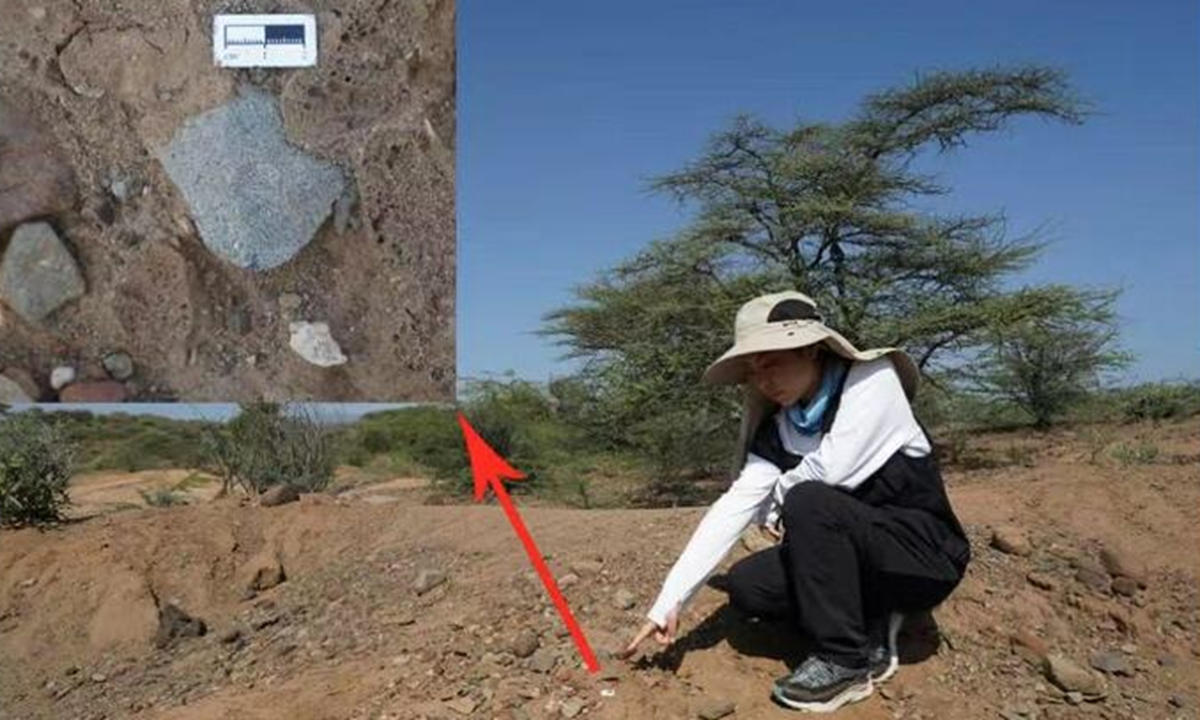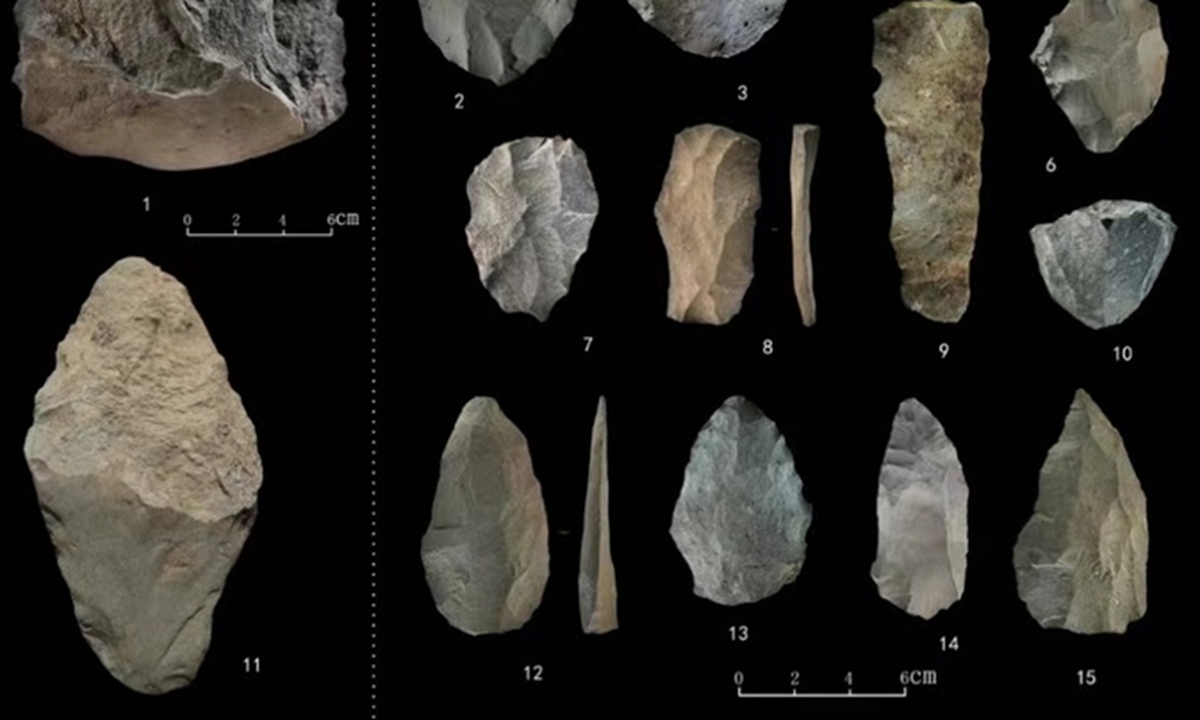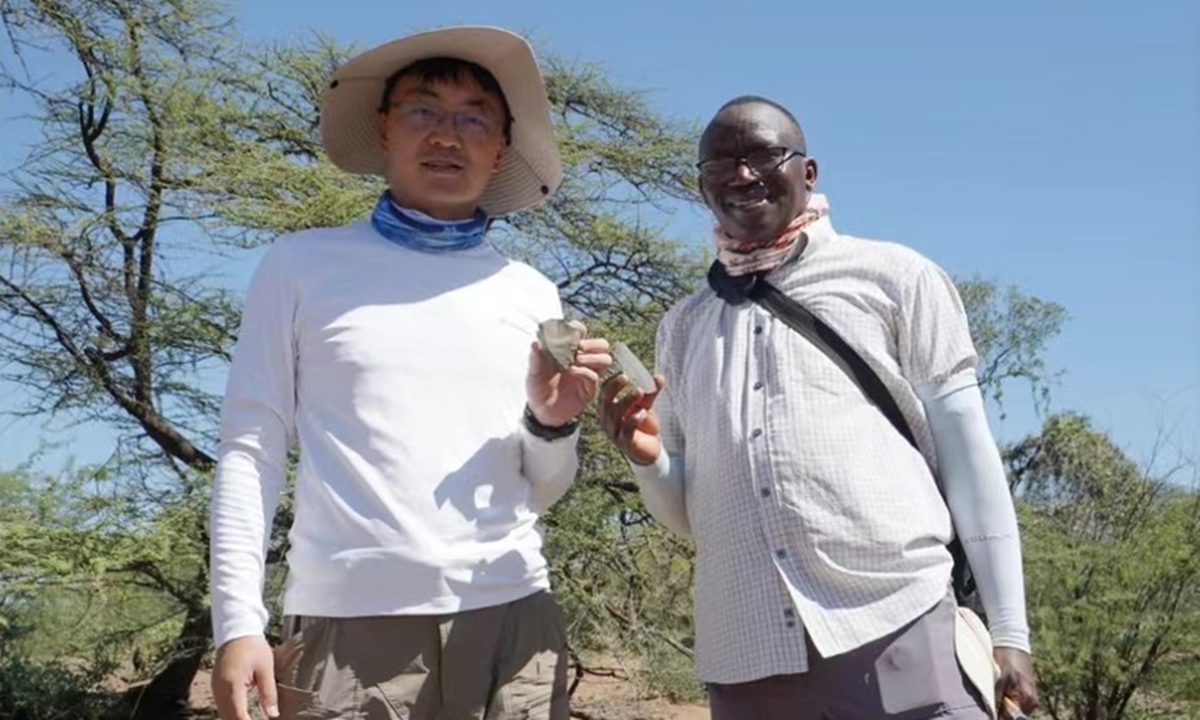ARTS / CULTURE & LEISURE
Paleolithic relics discovered by China, Kenya shed light on human evolution
A team of Chinese and Kenyan experts has made a major breakthrough in the field of Paleolithic archaeology with the discovery of the Levallois technique in Kenya, a sophisticated tool-making method that dates back more than 200,000 years, according to a leading member of the experts.

Zhao Qingbo, the Chinese site leader of the China-Kenya Paleolithic project as well as the deputy director of the prehistoric research department of the Henan Provincial Institute of Cultural Relics and Archaeology, told the Global Times that excavation efforts in 2023 focused on the second and third sites at Lake Bogoria in Baringo county in western Kenya, revealing an extensive area of 87 square meters. The team unearthed 750 stone tools alongside various animal fossils.
"The collaborative effort has led to the exploration of 22 Paleolithic sites and the analysis of over 2,000 stone artifacts. Among the most significant are Lower Paleolithic cultural relics, such as chopping axes, hand axes, and pickaxes, as well as middle Paleolithic pointed tools and stone flakes created using the Levallois technique," Zhao noted.
The team also uncovered Upper Paleolithic artifacts, including refined stone flakes, stone cores, and scrapers. Zhao emphasized that the Levallois technique exemplifies a key technological advancement in stone tool production during the era utilizing Middle Paleolithic stone tool-making techniques and represents a crucial milestone in the narrative of human evolution.
These archaeological contributions were highlighted among the six major findings of 2023 by the Chinese Academy of Social Sciences, underscoring the importance of this international collaboration in enhancing understanding of early human societies.
In 2014, the Henan Provincial Administration of Cultural Heritage and the National Museums of Kenya signed a cooperation framework agreement. Building on this foundation, in 2017, both parties signed their first cooperative excavation agreement.
Since then, archaeological surveys and excavations have been carried out at the Jemenjiki Stone Site and Bogoria Lake Site in Kenya, resulting in the discovery of 45 Paleolithic sites and yielding fruitful results from the excavation work.

"The content of this cooperative intention includes research on human evolution, comparative studies of the Paleolithic cultures of China and Kenya, cooperation in scientific archaeology, etc. It will establish a good foundation for future multidimensional cooperation between China and Kenya in cultural heritage protection, international platforms, and more," Zhao said.
Wei Xingtao, deputy chief of the Henan Provincial Institute of Cultural Heritage and Archaeology and also the Chinese leader of the China-Kenya Paleolithic Joint Archaeological Project, said that Chinese scholars going abroad to carry out archaeological work around the world is not only an inevitable requirement for the development of Chinese archaeology to a certain stage, but also an inevitable result of the economic and cultural development of the whole country.

The archaeological work with Chinese archaeologists as the main body and long-term topics as the orientation has gradually become the new norm for Chinese archaeology, said Wei.
With Chinese experts in archaeology working in other countries, their expertise is driving the exploration and research of human civilization in the world to a deeper level, sharing new skills and experience between the teams.

Stone flakes from the Levallois technique Photo: Henan Daily
This discovery marks a pivotal moment in understanding human evolution. During a joint archaeology seminar held on Wednesday in Zhengzhou, Central China's Henan Province, experts unveiled the latest findings from the Lake Bogoria site in Kenya, encompassing discoveries found in 2023 as part of the collaborative initiative.Zhao Qingbo, the Chinese site leader of the China-Kenya Paleolithic project as well as the deputy director of the prehistoric research department of the Henan Provincial Institute of Cultural Relics and Archaeology, told the Global Times that excavation efforts in 2023 focused on the second and third sites at Lake Bogoria in Baringo county in western Kenya, revealing an extensive area of 87 square meters. The team unearthed 750 stone tools alongside various animal fossils.
"The collaborative effort has led to the exploration of 22 Paleolithic sites and the analysis of over 2,000 stone artifacts. Among the most significant are Lower Paleolithic cultural relics, such as chopping axes, hand axes, and pickaxes, as well as middle Paleolithic pointed tools and stone flakes created using the Levallois technique," Zhao noted.
The team also uncovered Upper Paleolithic artifacts, including refined stone flakes, stone cores, and scrapers. Zhao emphasized that the Levallois technique exemplifies a key technological advancement in stone tool production during the era utilizing Middle Paleolithic stone tool-making techniques and represents a crucial milestone in the narrative of human evolution.
These archaeological contributions were highlighted among the six major findings of 2023 by the Chinese Academy of Social Sciences, underscoring the importance of this international collaboration in enhancing understanding of early human societies.
In 2014, the Henan Provincial Administration of Cultural Heritage and the National Museums of Kenya signed a cooperation framework agreement. Building on this foundation, in 2017, both parties signed their first cooperative excavation agreement.
Since then, archaeological surveys and excavations have been carried out at the Jemenjiki Stone Site and Bogoria Lake Site in Kenya, resulting in the discovery of 45 Paleolithic sites and yielding fruitful results from the excavation work.

Stone tools found at the excavation site Photo: Henan Daily
At the seminar, officials from both sides signed an agreement on China-Kenya joint archaeology cooperation from 2024 to 2029. Both parties intend to continue the ongoing China-Kenya joint Paleolithic archaeology project, contributing to the exchange and mutual learning of civilizations."The content of this cooperative intention includes research on human evolution, comparative studies of the Paleolithic cultures of China and Kenya, cooperation in scientific archaeology, etc. It will establish a good foundation for future multidimensional cooperation between China and Kenya in cultural heritage protection, international platforms, and more," Zhao said.
Wei Xingtao, deputy chief of the Henan Provincial Institute of Cultural Heritage and Archaeology and also the Chinese leader of the China-Kenya Paleolithic Joint Archaeological Project, said that Chinese scholars going abroad to carry out archaeological work around the world is not only an inevitable requirement for the development of Chinese archaeology to a certain stage, but also an inevitable result of the economic and cultural development of the whole country.

Zhao Qingbo (left) and Job Kibii, team leads of the China-Kenya Paleolithic Joint Archaeological Project, show off newly discovered stone artifacts made with the Levallois technique. Photo: Henan Daily
The joint archaeology of Paleolithic tools by China and Kenya is a concrete practice of China-Africa cultural relics and archaeological exchanges and cooperation under the Belt and Road Initiative, he noted.The archaeological work with Chinese archaeologists as the main body and long-term topics as the orientation has gradually become the new norm for Chinese archaeology, said Wei.
With Chinese experts in archaeology working in other countries, their expertise is driving the exploration and research of human civilization in the world to a deeper level, sharing new skills and experience between the teams.
